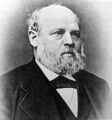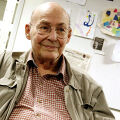Template:Selected anniversaries/January 24: Difference between revisions
No edit summary |
No edit summary |
||
| Line 57: | Line 57: | ||
File:Cosmos-954 debris.png|link=Kosmos 954 (nonfiction)|1978: Soviet satellite [[Kosmos 954 (nonfiction)|Kosmos 954]], with a nuclear reactor on board, burns up in Earth's atmosphere, scattering radioactive debris over Canada's Northwest Territories. Only 1% is recovered. | File:Cosmos-954 debris.png|link=Kosmos 954 (nonfiction)|1978: Soviet satellite [[Kosmos 954 (nonfiction)|Kosmos 954]], with a nuclear reactor on board, burns up in Earth's atmosphere, scattering radioactive debris over Canada's Northwest Territories. Only 1% is recovered. | ||
File:Meander Boys.jpg|link=Meander Boys|1980: The song "'''[[Meander Boys]]'''" by American rock band and consulting fluvial geologists NRBQ reaches Number One on the Sedimentary Deposits chart. | |||
||1982: Karol Borsuk dies ... mathematician. His main interest was topology. Borsuk introduced the theory of absolute retracts (ARs) and absolute neighborhood retracts (ANRs), and the cohomotopy groups, later called Borsuk–Spanier cohomotopy groups. He also founded Shape theory. He has constructed various beautiful examples of topological spaces, e.g. an acyclic, 3-dimensional continuum which admits a fixed point free homeomorphism onto itself; also 2-dimensional, contractible polyhedra which have no free edge. His topological and geometric conjectures and themes stimulated research for more than half a century. Pic. | ||1982: Karol Borsuk dies ... mathematician. His main interest was topology. Borsuk introduced the theory of absolute retracts (ARs) and absolute neighborhood retracts (ANRs), and the cohomotopy groups, later called Borsuk–Spanier cohomotopy groups. He also founded Shape theory. He has constructed various beautiful examples of topological spaces, e.g. an acyclic, 3-dimensional continuum which admits a fixed point free homeomorphism onto itself; also 2-dimensional, contractible polyhedra which have no free edge. His topological and geometric conjectures and themes stimulated research for more than half a century. Pic. | ||
Revision as of 08:42, 24 January 2022
1798: Mathematician Karl Georg Christian von Staudt born. He will use synthetic geometry to provide a foundation for arithmetic.
1879: Glassblower, physicist, and inventor Johann Heinrich Wilhelm Geißler dies. He invented the Geissler tube, made of glass and used as a low pressure gas-discharge luminescence tube.
1961: Goldsboro B-52 crash: A bomber carrying two H-bombs breaks up in mid-air over North Carolina. The uranium core of one weapon remains lost.
1978: Soviet satellite Kosmos 954, with a nuclear reactor on board, burns up in Earth's atmosphere, scattering radioactive debris over Canada's Northwest Territories. Only 1% is recovered.
1980: The song "Meander Boys" by American rock band and consulting fluvial geologists NRBQ reaches Number One on the Sedimentary Deposits chart.
1988: Mathematician and academic Werner Fenchel dies. He established the basic results of convex analysis and nonlinear optimization theory which would, in time, serve as the foundation for nonlinear programming.
2016: Cognitive scientist and artificial intelligence researcher Marvin Minsky dies. Minsky's inventions include the first head-mounted graphical display (1963) and the confocal microscope (1957, a predecessor to today's widely used confocal laser scanning microscope).






